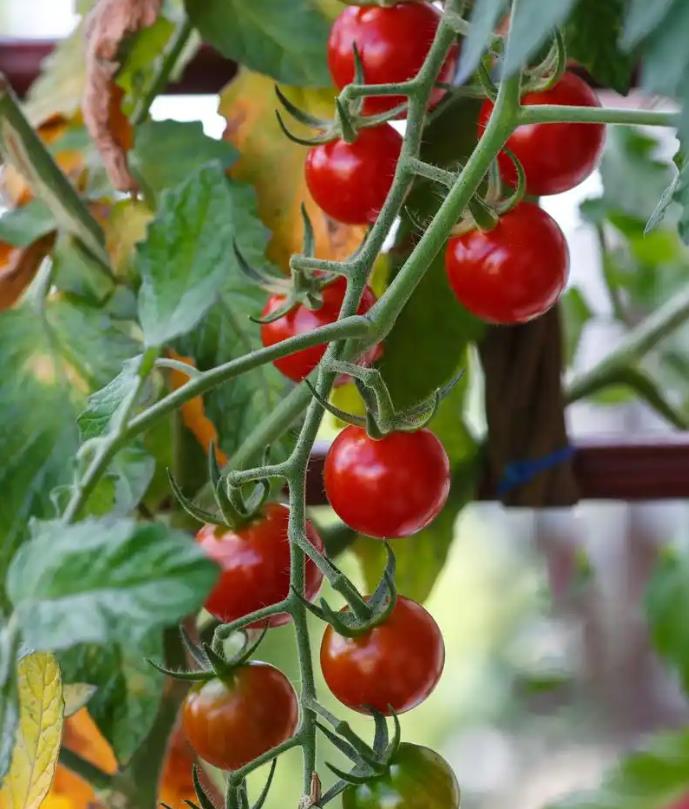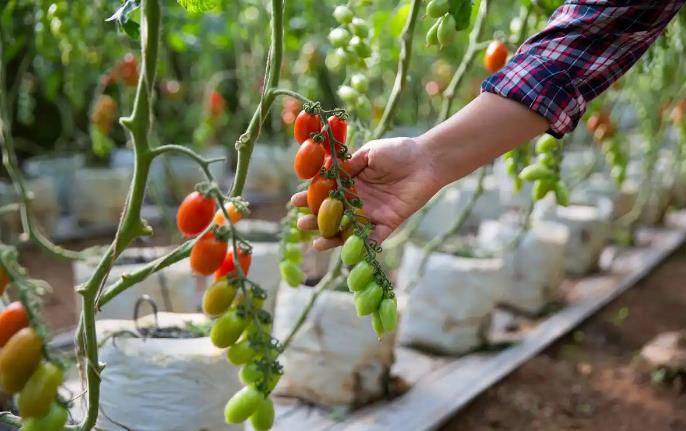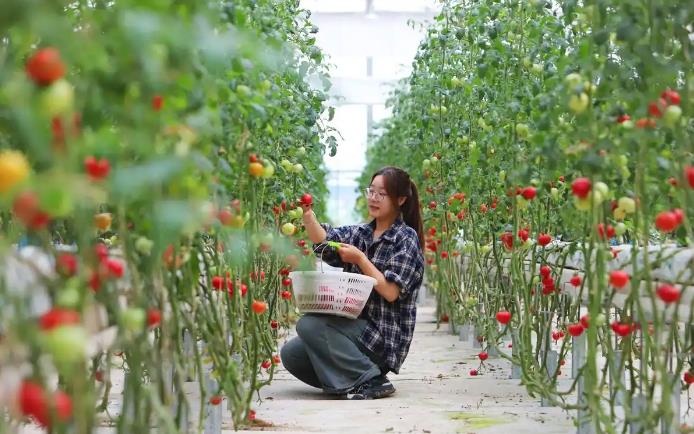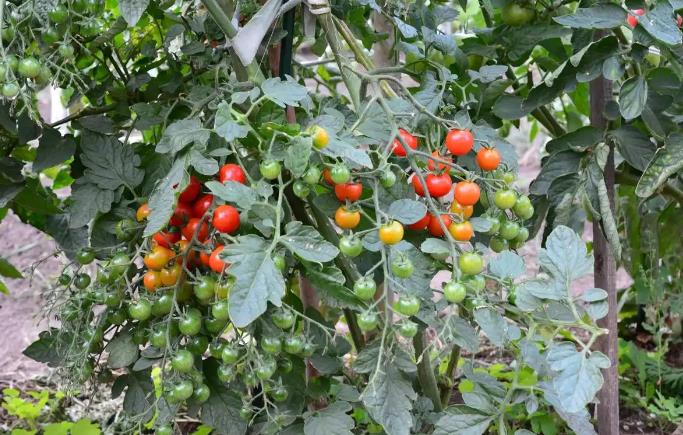How and when to plant tomatoes! A complete guide to growing tomatoes: a scientific guide from sowing to harvest!
1. Regional differences in tomato planting time
The planting time of tomatoes is significantly affected by the regional climate. Different regions need to determine the best planting time according to local environmental conditions to ensure healthy growth and high yield of tomatoes.

1.1 Northern region: mainly spring sowing, mulch insulation
The temperature in the northern region rises slowly in spring, and there are often late spring cold. Tomatoes planted in the open field need to avoid low temperature periods. The best planting time is from mid-to-late April to early May. At this time, the ground temperature is stable above 10℃, which can meet the needs of tomato seed germination and seedling growth. Taking some areas in the northeast as an example, before mid-April in previous years, the soil temperature was low, and tomato seeds did not germinate for a long time after sowing, and they were easy to rot. After sowing in late April, the seeds germinated smoothly and the seedlings grew vigorously. If you want to sow in advance, you can use mulch covering technology, which can increase the ground temperature by 2-3℃ and sow 10-15 days in advance. When selecting seeds, cold-resistant and early-maturing varieties should be selected, such as "Green Dragon", which has strong cold resistance, grows well in low temperature environments, and can mature and go on the market early. In terms of planting density, it is more appropriate to keep about 7,000 seedlings per mu, which can ensure that the plants have sufficient growth space and nutrient supply. At the same time, it should be noted that late frost sometimes occurs in the spring in the north, which is very harmful to tomato seedlings. A small arch shed can be built after sowing, and warm materials such as straw thatch and quilts can be covered before frost, and removed in time after frost to protect the seedlings from frost damage.

1.2 Southern regions: double-season planting and staggered listing
The climate in the south is warm and humid, and tomatoes can be planted in spring and autumn. Spring sowing can be appropriately advanced, and sowing can be done in late February to early March. At this time, the temperature gradually rises and the rain is abundant, which is conducive to the growth of tomatoes. For example, in some areas of Guangdong, sowing is done in late February, transplanting is done in mid-March, and harvesting can be done in mid-May, which is nearly two months earlier than in the north, seizing the market opportunity and obtaining better economic benefits. The autumn planting time is from September to October. At this time, the summer high temperature gradually subsides, and the temperature difference between day and night increases, which is suitable for the growth and development of tomatoes. However, the temperature in the early autumn in the south is still high, so it is necessary to choose high-temperature resistant varieties, such as "Xiabao", which has a high fruit setting rate and good fruit quality in a high temperature environment. There is a lot of rain in the south, so it is advisable to adopt deep furrows and high ridges when planting. The ridge height is 20-30 cm and the furrow width is 30-40 cm. It can effectively drain the water in the field, prevent the roots of tomatoes from rotting due to lack of oxygen due to water accumulation, and reduce the occurrence of diseases such as root rot. According to statistics, the yield of spring-sown tomatoes per mu can reach 8,000 kilograms by adopting deep furrows and high ridges. When planting in autumn, the temperature is high in the early stage and the sunlight is strong. It is necessary to do a good job of shading and cooling. You can build a shade net to reduce the light intensity and temperature to create a suitable environment for tomato growth.
1.3 Special climate zones: flexible adjustment, facility assistance
In high-altitude cold and cool areas, such as some plateau areas in Yunnan and Guizhou, the climate is cool in summer. Tomatoes are sown in May and June. Taking advantage of the local low temperature in summer, the tomatoes produced are full, taste good, and sweet, which are very popular in the market. In some areas of South China, such as the coastal areas of Guangdong, there are many typhoons and rainstorms in summer. Sowing tomatoes in autumn from August to September can avoid the typhoon season and ensure the growth and harvest of tomatoes. With the development of facility agriculture, greenhouse planting allows tomatoes to achieve year-round production. By installing supplementary lights in the greenhouse, light can be supplemented when light is insufficient to meet the photosynthesis needs of tomatoes; using temperature control equipment, cooling in summer and heating in winter, the temperature is controlled within the suitable range for tomato growth (20-28℃), extending the tomato harvest period, achieving year-round supply, and enriching the market.
2. Key points of tomato planting core technologies
Mastering the key points of tomato planting core technologies is the key to achieving high yield and high quality of tomatoes, covering many important links such as variety selection, soil improvement, sowing and seedling raising.

2.1 Variety selection and seed treatment
Variety selection: Variety selection should be adapted to local conditions. The northern region is cold in winter, so choosing cold-resistant varieties is the key. For example, "Disease-Resistant Pioneer" has excellent cold resistance, can maintain a good growth trend in a low temperature environment, and has excellent fruit quality. It is an ideal choice for planting in the north. The southern summer is hot, and "Golden Queen" has strong heat resistance. It can still bloom and bear fruit normally in high temperature weather. The fruit is sweet and tastes good, and is favored by southern growers. If it is planted in a small space such as a balcony, "Millennium Cherry Tomato" is recommended. Its plants are short and compact, suitable for potted plants, and the fruit is small and exquisite, with high sweetness. It has both ornamental and edible value and is deeply loved by home growers.
Seed treatment: Seed treatment before sowing is very important. First, soak the seeds in warm water. Soak the seeds in 55℃ warm water for 15 minutes. Stir continuously during this process to ensure that the seeds are heated evenly, which can effectively kill the surface bacteria of the seeds and prevent a variety of diseases. After that, put the seeds in clean water to cool, and continue to soak for 4-6 hours to allow the seeds to fully absorb water and promote germination. Take out the seeds, wrap them with a wet cloth, and place them in a 25-30℃ environment for germination. Rinse them with clean water 1-2 times a day to prevent the seeds from getting moldy. When 70% of the seeds are white, they can be sown. At this time, the seed germination rate is high and the seedlings grow strong.
2.2 Soil improvement and base fertilizer application
Soil requirements: Tomatoes have high soil requirements and are suitable for growing in deep, fertile, loose and well-drained soil. Before sowing or transplanting, the soil needs to be plowed more than 30 cm to break the soil compaction layer, increase soil permeability and water retention, and facilitate the growth of tomato roots. The soil pH should be slightly acidic to neutral with a pH value of 6.0-7.5. Too acidic or too alkaline soil will affect the absorption of nutrients by tomatoes. The soil pH can be adjusted by applying lime or acidic fertilizer. Tomatoes should not be planted continuously. Continuous planting can easily lead to the accumulation of pathogens in the soil, causing pests and diseases, and also cause soil nutrient imbalance, reducing yield and quality. It is best to rotate with non-Solanaceae crops for 3-4 years.
Basal fertilizer formula: Basal fertilizer is the basis for tomato growth. Adequate basal fertilizer can provide long-term nutrient support for tomato growth. Generally, 3,000 kg of decomposed organic fertilizer is applied per mu. Organic fertilizer can improve soil structure, increase soil organic matter content, improve soil fertility, and create a good soil environment for tomato growth. With 50 kg of triple compound fertilizer, its nitrogen, phosphorus and potassium ratio is balanced, which can meet the nutrient needs of tomatoes at different growth stages. 50 kg of superphosphate can supplement phosphorus in the soil and promote tomato root development and flower bud differentiation. When fertilizing, spread the fertilizer evenly on the soil surface, then plow it into the soil to fully mix the fertilizer with the soil and improve fertilizer utilization.
2.3 Seeding, seedling raising and planting management
Sowing density: There are two sowing methods: row sowing and hole sowing. When sowing in rows, the row spacing is controlled at 50 cm. The seeds are evenly spread in the sowing furrow and covered with 1-2 cm thick fine soil. Row sowing is suitable for large-scale planting and is convenient for field management and mechanized operations. The row spacing of hole sowing is 50 cm × 30 cm. 2-3 seeds are sown in each hole. After sowing, cover the soil and water. Hole sowing can ensure that each tomato plant has sufficient growth space and nutrient supply, which is suitable for small-scale planting or family planting. After sowing, keep the soil moist and control the temperature at 20-25℃ to facilitate seed germination. The seeds can germinate and emerge in 3-5 days.
Planting standard: When the seedlings grow to 4-5 true leaves, they meet the transplanting and planting standards. Before planting, dig planting furrows in the field according to the row spacing, with a depth of 15-20 cm. Transplant the seedlings with soil into the planting ditch. The spacing between plants is determined according to the variety and planting density, generally 30-40 cm. When transplanting, pay attention to keeping the seedling root system intact to avoid damaging the root system and affecting the survival and growth of the seedlings. The planting depth is based on the level of the cotyledon node and the ground surface. Too deep or too shallow will affect the growth of the seedlings. After planting, water the roots in time. The water should be thoroughly poured to make the soil and the root system closely combined, promote root growth, and improve the survival rate of seedlings.
3. Field fine management plan
3.1 Precise regulation of water and fertilizer
Water management: Tomatoes have different water requirements at different growth stages. After planting, water them once in the morning and evening every day. At this time, the root system of the plant has not yet fully adapted to the new environment and has weak water absorption capacity. Frequent watering with small amounts of water can keep the soil moist, promote root growth, and improve the survival rate of seedlings. After the seedlings have grown, the watering frequency can be adjusted to once every 2-3 days, and the soil moisture can be maintained at 60%-70%. Moderate water control can prevent the plant from growing too tall and promote root growth. In the fruiting period, tomatoes grow vigorously and the fruit needs a lot of water to expand. Water once every 3 days to ensure that the soil is moist to meet the growth needs of the plants, but be careful to avoid water accumulation, otherwise it will cause the roots to rot due to lack of oxygen and cause diseases such as root rot.
Topdressing strategy: The seedling stage is the basic stage of tomato growth. In order to promote root development and enhance plant resistance, rooting agents + microbial agents can be applied. Rooting agents can stimulate root cell division and promote new root growth; microbial agents can improve the soil microbial environment, increase the number of beneficial microorganisms in the soil, improve soil fertility, and provide good soil conditions for plant growth. Entering the fruit expansion period, tomatoes have a great demand for potassium. At this time, high potassium water-soluble fertilizer (N-P-K = 10-5-40) should be added. Potassium can promote fruit expansion, improve fruit sugar accumulation and quality. In the peak fruit period, in order to prevent premature aging of the plant, spray 0.3% potassium dihydrogen phosphate solution on the leaves every 7-10 days to supplement phosphorus and potassium, enhance leaf photosynthesis, extend the leaf functional period, and improve fruit yield and quality.
3.2 Pruning and leafing technology
Pruning method: The pruning method should be selected according to the planting density and variety characteristics. The single stem pruning method is simple and efficient, suitable for dense planting. Only the main stem is retained and all other side branches are removed. It can concentrate nutrients on the main stem and fruit, increase early yield and total yield, and the fruit is large, but the yield per plant is low. In addition to retaining the main stem, the double-stem pruning method also retains the first side branch under the first inflorescence, and the remaining side branches are removed. This method allows the plant to grow robustly, with high yield per plant and a long harvest period. It is suitable for strong growth, small fruit, medium and late maturing varieties and small planting density plots, but the early yield is low, which is not conducive to early maturity on the market.
Leaf removal standard: Leaf removal is an important part of field management, which can improve ventilation and light transmission conditions and reduce the occurrence of pests and diseases. When the leaves at the base of tomatoes turn yellow, age or are infected with pests and diseases, they should be removed in time to prevent these leaves from consuming nutrients and spreading pathogens. When removing leaves, retain 10-15 functional leaves at the top of each plant. Functional leaves can photosynthesize and provide nutrients for plant growth and fruit development. Leaf removal should be carried out in the morning on a sunny day, when the temperature is high, the light is strong, the wound heals quickly, and the chance of bacterial infection can be reduced; avoid leaf removal on rainy days or when the dew has not dried to prevent wound infection.
3.3 Key measures during the flowering and fruiting period
Flower and fruit preservation: Tomatoes have a high demand for boron during the flowering period. Boron can promote pollen germination and pollen tube elongation, and improve pollination and fertilization rates. During the flowering period, 0.2% borax solution can be sprayed every 7-10 days, and sprayed 2-3 times in a row, which can effectively increase the fruit setting rate. During the young fruit period, to prevent flowers and fruits from falling, 2,4-D (10-15ppm) can be sprayed. 2,4-D is a plant growth regulator that can regulate plant growth and development, promote fruit enlargement, and increase yield. The concentration must be strictly controlled during use. Too high a concentration can easily cause drug damage and cause fruit deformities; too low a concentration will have a poor effect. When spraying, choose 9-11 am on a sunny day. At this time, the flowers are open and the agent is easily absorbed, which can improve the effect of flower and fruit preservation.
Thinning flowers and fruits: Tomatoes have a large number of flowers. If they are not thinned, the fruit size will be uneven and the quality will decline. Flower thinning is carried out at the early stage of flowering, and deformed and weak flowers are removed. 3-5 strong flowers are retained in each ear to concentrate nutrients and ensure uniform fruit size and good quality. Fruit thinning is carried out after the fruit is set, usually starting when the fruit grows to the size of soybeans, and deformed, small and diseased fruits are removed. 3-5 fruits are retained in each ear to ensure that the fruit has sufficient growth space and nutrient supply, and improve the commercial value of the fruit. When thinning flowers and fruits, the action should be gentle to avoid damaging the plant and the retained flowers and fruits.
4. Integrated pest and disease control system
Pests and diseases are important factors affecting tomato yield and quality. Establishing an integrated pest and disease control system can effectively reduce the incidence of pests and diseases and ensure the safety of tomato production.
4.1 Prevention and control of major diseases
Root rot: Root rot is a common disease of tomatoes. In the early stage of the disease, the plant grows slowly, the leaves turn yellow and wilt, and in severe cases, the whole plant dies. The pathogen is Fusarium solani, which can survive in the soil for many years and invade the plant through root wounds. To prevent root rot, crop rotation should be implemented to avoid continuous cropping with Solanaceae crops. It can be rotated with crops such as onions and garlic, and the root secretions of onions and garlic can be used to inhibit the growth of pathogens. When the disease occurs, 77% Keshade 800 times liquid can be used for root irrigation, with a dosage of 200-300 ml per plant, once every 7-10 days, and 2-3 consecutive irrigations, which can effectively inhibit the development of the disease. According to experiments, the prevention and control of root rot by crop rotation combined with root irrigation with pesticides can reach more than 85%.
Late blight: Late blight is a devastating disease of tomatoes, mainly harming leaves, stems and fruits. The leaves are infected, mostly starting from the tip and edge of the leaves. They are initially dark green, water-soaked, irregular lesions, which then turn brown. When the humidity is high, white mold grows at the junction of the diseased and healthy leaves on the back of the leaves, and the entire leaf rots. The stems are infected, producing long dark brown sunken stripes, which can make the stems thinner and dark brown, and eventually cause the plants to wilt or fall over. Under high humidity conditions, the diseased parts will produce a white mold layer. The fruit is infected first on the green fruit. The lesions are initially oily dark green, and then turn into dark brown or brown, irregular cloud-like, slightly sunken, with obvious edges. The fruit generally does not soften. When the humidity is high, a small amount of white mold may be produced and rot quickly. The pathogen is Phytophthora infectabilis, which spreads by airflow, wind and rain, and irrigation, and directly invades through the stomata and epidermis. In the early stage of the disease, spray with 1000 times of 68% fine A-manganese zinc, spray once every 7-10 days, and spray 3-4 times continuously, which can effectively control the spread of the disease.

4.2 Green pest control
Aphids: Aphids are common pests of tomatoes. They suck the juice of tomato plants with piercing-sucking mouthparts, causing the leaves to curl and shrink, and growth to be stunted. They also spread viral diseases and cause tomato viral diseases to spread. Aphids have strong reproductive capacity and can reproduce a generation in 4-5 days under suitable conditions. In physical control, yellow boards can be hung in the field to trap aphids by taking advantage of their tendency to yellow. 30 yellow boards of 25 cm × 30 cm can be hung per mu. The height of the yellow boards should be 10-15 cm higher than the growing point of tomatoes, which can effectively reduce the number of aphids. In chemical control, spray 70% imidacloprid 3000 times diluted, focusing on the back of the leaves and tender shoots, which can quickly kill aphids. Imidacloprid is systemic and can be absorbed by the plant and transmitted to various parts to continuously exert its insecticidal effect.
Cotton bollworm: Cotton bollworm is one of the main pests of tomatoes. The larvae eat tomato buds, flowers and fruits, and can also harm tender stems, leaves and young shoots. Young fruits are often bitten and become hollow and rotten. When part of the fruit flesh is bitten, it will also cause rot and fall off, seriously affecting the yield and quality of tomatoes. Cotton bollworm has 4-5 generations a year and overwinters in the soil as pupae. For green prevention and control, sex attractant traps can be set up in the field, with 3-5 traps placed per acre.
Documentation 2025-05-13 23:33 Revise
踩一下[0]

 admin
admin
顶一下[0]